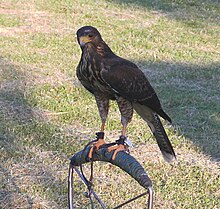Desert buzzard
| Desert buzzard | ||||||||||
|---|---|---|---|---|---|---|---|---|---|---|

Desert Buzzard ( Parabuteo unicinctus ) |
||||||||||
| Systematics | ||||||||||
|
||||||||||
| Scientific name | ||||||||||
| Parabuteo unicinctus | ||||||||||
| ( Temminck , 1824) |

The desert buzzard ( Parabuteo unicinctus ) ( Parabuteo "similar to the buzzard"), sometimes also referred to by its English name Harris's Hawk , is a medium-sized bird of prey from the hawk family (Accipitridae).
Desert buzzards are the only species of birds of prey that hunt in groups. They are protected by the Washington Convention on the Protection of Species according to Appendix II ( CITES ).
External features
Desert buzzards reach a wingspan of 110 to 120 cm with a body length of 55 to 60 cm and a weight of 750 to 1100 grams. The females are around ten percent larger than their male counterparts. The plumage is predominantly dark brown, the leg feathers, especially in old age, reddish brown in color. A reddish-brown color is also evident on the shoulders. Much lighter, almost cream-colored, are the belly and chest side. The white plumage on the underside of the tail is striking. The long, strong bill is yellow at the base and goes over light gray to dark gray at its tip.
Way of life
Desert buzzards live in small, loose family groups, but contrary to many claims do not enter into lifelong ties. The group size varies, but often it is five birds, with a dominant female leading the group. One group occupies an area of around 5 km². The main enemies, depending on the area of distribution, are large owls, ravens and coyotes. The great aversion to coyotes can be carried over to dogs when kept in captivity. Wild buzzards live between ten and fifteen years. Animals kept in captivity can live up to 20 years.
Reproduction
Desert buzzards reach sexual maturity at 18 to 24 months. In good hunting areas, they breed all year round. The nest is usually on cacti, pines or trees five to ten meters high. The nesting material consists of roots, sticks, weeds and moss and is padded with hair and feathers. The eyrie is usually built very flat. The male takes over the basic structure, the female completes the nest. It happens that up to three males build a nest. The female lays around two to five eggs every three days in March (first brood of the year); the number depends on the food available. The eggs are the size of a hen's eggs, white and have a slightly bluish tinge. The female breeds, the males look for food, but also defend the nest. The breeding season lasts 33 to 35 days. Several birds also take part in the rearing and defense of the young. 17 days after hatching, the young birds are already feathered all over their bodies. About 40 days after hatching, the young birds fledge and temporarily leave the nest, but remain near it for two to three months. Young birds do not yet have the same social behavior as adult birds. With a good food supply, a pair of desert buzzards can breed up to three times a year. A family association can exist for up to three years. The young birds from the previous year each take part in the care of the new siblings.
hunt

Desert buzzards hunt in a group, led by an older, experienced bird. A desert buzzard is not quite as agile as a hawk , but can withstand a longer distance in pursuit. The group strategies used by the birds are different. They hunt from hides like cacti or telephone poles and pursue fleeing prey in a relay flight, or they circle around from their hides and thus cut off their return or escape route. If a prey creeps into the thicket, some birds land and drive them back out on foot, where they are killed or beaten by members of the group waiting to sit down. The division of labor in hunting is not fixed and changes from situation to situation. Some birds act as drivers on the ground, sometimes as hunters in the air. The prey spectrum ranges from small birds to lizards, snakes, rodents and rabbits. When chasing lizards, the desert buzzard also begins to scratch, similar to the honey buzzard .
habitat
Contrary to its name, the desert buzzard inhabits different habitats. In addition to dry to semi-arid deserts, semi-deserts and steppes, it can also be found in swamp areas, sparsely vegetated grassland with little trees and up to a height of 1000 meters. Some zoologists suspect that his social way of life is a survival strategy, which can be traced back to the barren existence in dry areas.
Subspecies
There are three known subspecies, which differ mainly in the pattern of their plumage.
- Parabuteo unicinctus harrisi
Light brown markings on the chest and stomach.
- Parabuteo unicinctus superior
Shoulders yellow ocher, legs pink. Largest subspecies.
- Parabuteo unicinctus unicinctus .
distribution
The distribution area of the desert buzzard extends from the southwest of the USA via Mexico and Central America to Patagonia . The distribution area of the individual subspecies is as follows: Parabuteo unicinctus harrisi lives in southern Texas, in Mexico (excluding Northwest Mexico), in Central America to western Ecuador and in northern Peru. Parabuteo unicinctus superior lives in southeastern California, southwestern Arizona, and western Mexico. Parabuteo unicinctus unicinctus lives in southern Chile, central Argentina, Paraguay, Brazil and eastern Venezuela.
literature
- Bernhard Grzimek: Grzimeks animal life. Volume 7-9 birds. Deutscher Taschenbuch Verlag GmbH & Co. KG Munich 1993, ISBN 3-423-05970-2
- Gottfried Mauersberger, Wilhelm Meise: Urania animal kingdom. 7 vols., Birds. Urania, Stuttgart 1995, ISBN 3423032049
Web links
- Parabuteo unicinctus inthe IUCN Red List of Threatened Species 2013.1. Listed by: BirdLife International, 2012. Retrieved September 3, 2013.

